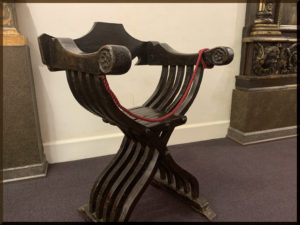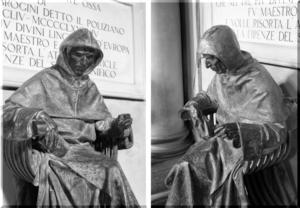Savonarola Chair
Walnut
Florentine, early 16th century
For a mundane piece of furniture with such a simplistic design as to be easily transportable, this folding chair bears the name of a big personality and has allowed countless VIPs to rest and rule simultaneously.
Girolamo Savonarola was a monk and religious reformer in Florence, Italy. He came to the Medici’s city in 1481 to serve at the Dominican monastery and church of San Marco (St. Mark). He proved to be honest and sincere, and he studied and memorized Scripture, which he applied practically to everyday living for himself and in his teaching. His preaching was passionate and dramatic, and he spoke against corruption in the church and papacy. His influence for morality and reform held popular support for a while, even garnering respect from Lorenzo, the Magnificent. Eventually, however, Savonarola was bitterly opposed by Rome. The pope enforced excommunication, suspension of the sacraments from the faithful, and a ban of trade, which affected Florence’s prosperous economy. Ultimately, the Florentines turned on him too, and Savonarola was sentenced to death. He was hanged and his body burned in the town square in 1498—just seventeen years after his arrival.
Shaped in the frame of an X, this Italian Renaissance Savonarola Chair is one of a few in M&G’s collection. The chair is constructed of walnut and is considered “unusual” by furniture expert Joseph Aronson because it only has five pairs of the thick, pivoted S-shaped strips of wood to hold the hinged seat. Normally, a chair like this might have six, eight, or even twelve pairs. However, these five rung pairs are each held together at the floor with a trestle for sturdiness, and the pairs are joined at the top by heavy arms with carved rosettes. The back of the chair is a modest board, which is attached loosely—easily removed when the chair needs to be folded.
The chair style has had many names through the centuries and geographical regions including the X-chair, curule, faldstool, scissors chair, Dante chair, and Luther chair. Because of its unique design, the chair traces its roots and practical service back to antiquity. A visual record exists of Egyptian Pharoah Tut’ankhamun sitting in the chair. Roman senators and consuls used a backless version of these portable seats, and in Romanesque and Gothic illuminations the kings of France are perched on it.
With Italy’s interest in Greek and Roman culture and thought, the Renaissance also revived awareness in the architecture and design from antiquity including furniture. One writer explains the era as “an exhibition of emancipated modern genius fired and illuminated by the masterpieces of the past.” During the awakening, the chair’s status of power continues in the pictorial records of seated bishops, emperors, and popes. Artists also rendered respected religious individuals in the chair such as St. Ambrose and Christ’s mother Mary.
The Museum of San Marco preserves and features the fifteenth-century Dominican monastery where Fra Angelico was Prior and who decorated many of the monk’s cells and interior spaces with beautiful frescoes. Girolamo Savonarola became the monastery’s Prior in 1491 and occupied three cells that today still display a few of his personal items, including a folding X-chair in his study and similar chairs in other parts of the museum.
However, it wasn’t until nearly 400 years after his torturous death that the chair became associated with Savonarola specifically. In 1878, Florentine sculptor Giovanni Biggi created for the church at San Marco a bronze statue of the monk sitting pensively in an X-shaped chair.
Erin R. Jones, Executive Director
Additional Reading:
Furniture of the Italian Renaissance, Walter A. Dyer
Michelangelo and Seats of Power, Eric Denker and William E. Wallace
Faith of Our Fathers: Scenes from Church History, edited by Mark Sidwell
Anatomy of A Design Classic: The Savonarola Chair
Published in 2020

